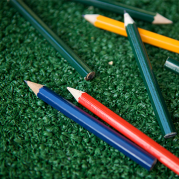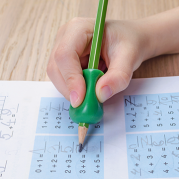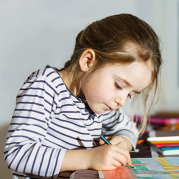How to help young kids with handwriting

By Amanda Morin
Expert reviewed by Ginny Osewalt
Quick tips to help with handwriting
- Quick tip 1Use golf pencils.
 Use golf pencils.
Use golf pencils.To help kids get a better grasp when they start learning to write, try golf pencils. These are the small pencils you see at mini-golf courses and bowling alleys. Their size makes them easier for little hands to hold on to and balance correctly.
- Quick tip 2Try pencil grips.
 Try pencil grips.
Try pencil grips.A pencil grip can help kids learn to hold a pencil properly. A great grip is the kind that looks like a squishy blob with fingerprints in it. Or you can make your own by rolling clay into a small ball and pushing it onto the tip of a pencil.
- Quick tip 3Choose the “write” time to play with food.
 Choose the “write” time to play with food.
Choose the “write” time to play with food.Practice writing letters in mashed potatoes, sugar, or flour. Spread the food on a flat surface. Kids can use their pointer finger to write letters or small words. Help them remember to move from top to bottom and left to right.
- Quick tip 4Use raised lines and textured surfaces.
 Use raised lines and textured surfaces.
Use raised lines and textured surfaces.Sometimes kids can’t feel themselves making letters when they write. Writing on textured surfaces helps. To get a textured surface, put paper on top of something bumpy, like sandpaper or a rough plastic placemat.
- Quick tip 5Emphasize the lines.
 Emphasize the lines.
Emphasize the lines.Trace the lines on lined paper with fabric paint or school glue, and let them dry. The pencil will “bump” the lines when kids write. Or you can highlight the top, middle, and bottom lines for emphasis.
Handwriting is a complex skill. Young kids have to hold their bodies in a certain way, apply the right pressure to the pencil, and hold the paper. Then they have to know how to start writing the letter, where it goes on the line, and so on.
It’s no wonder that young kids have trouble with handwriting. But there are plenty of ways to help, including activities to build fine motor skills and sensory experiences to help kids get a better “feel” for writing.
Using multiple senses gives kids more ways to connect with and remember what they’re learning. This is called multisensory learning, and it may be extra helpful for young kids. Writing letters in shaving cream or writing on textured surfaces are good examples.
Dive deeper
Helpful downloads and activities
Young kids can practice fine motor skills with fun activities. Try these six activities to build fine motor skills.
You can also use a “spacekid” to help young kids who leave too much or little space between words. Get a wooden craft stick. Put it down on the table pointing straight up and down. Ask kids to draw a face on the top so it looks like a person. This is their spacekid. When they write, have them put their spacekid down at the end of a word. The next word starts on the other side of the stick.
Download a spacekid template and other printables to help with handwriting.
Why kids struggle with handwriting
Young kids may not have mastered all of the skills they need for handwriting. Some kids take longer to develop these skills than others. And that’s OK.
If kids continue to have trouble with writing letters or words, they may be struggling with fine motor skills. These are skills that help us make movements using the small muscles in our hands and wrists. In other cases, poor handwriting can happen because kids are rushing through assignments.
Learn more about messy handwriting in kids.

